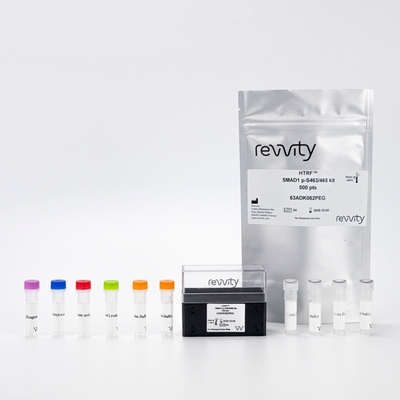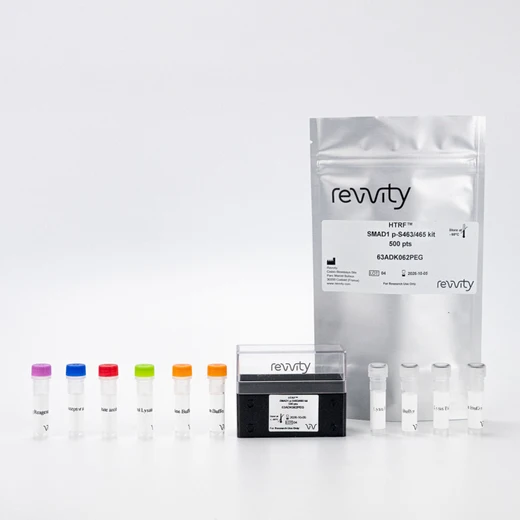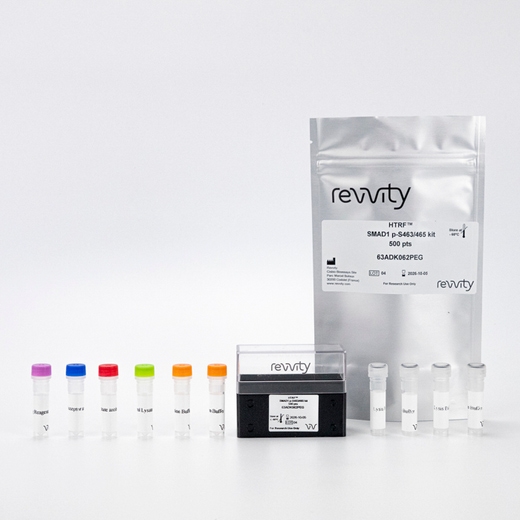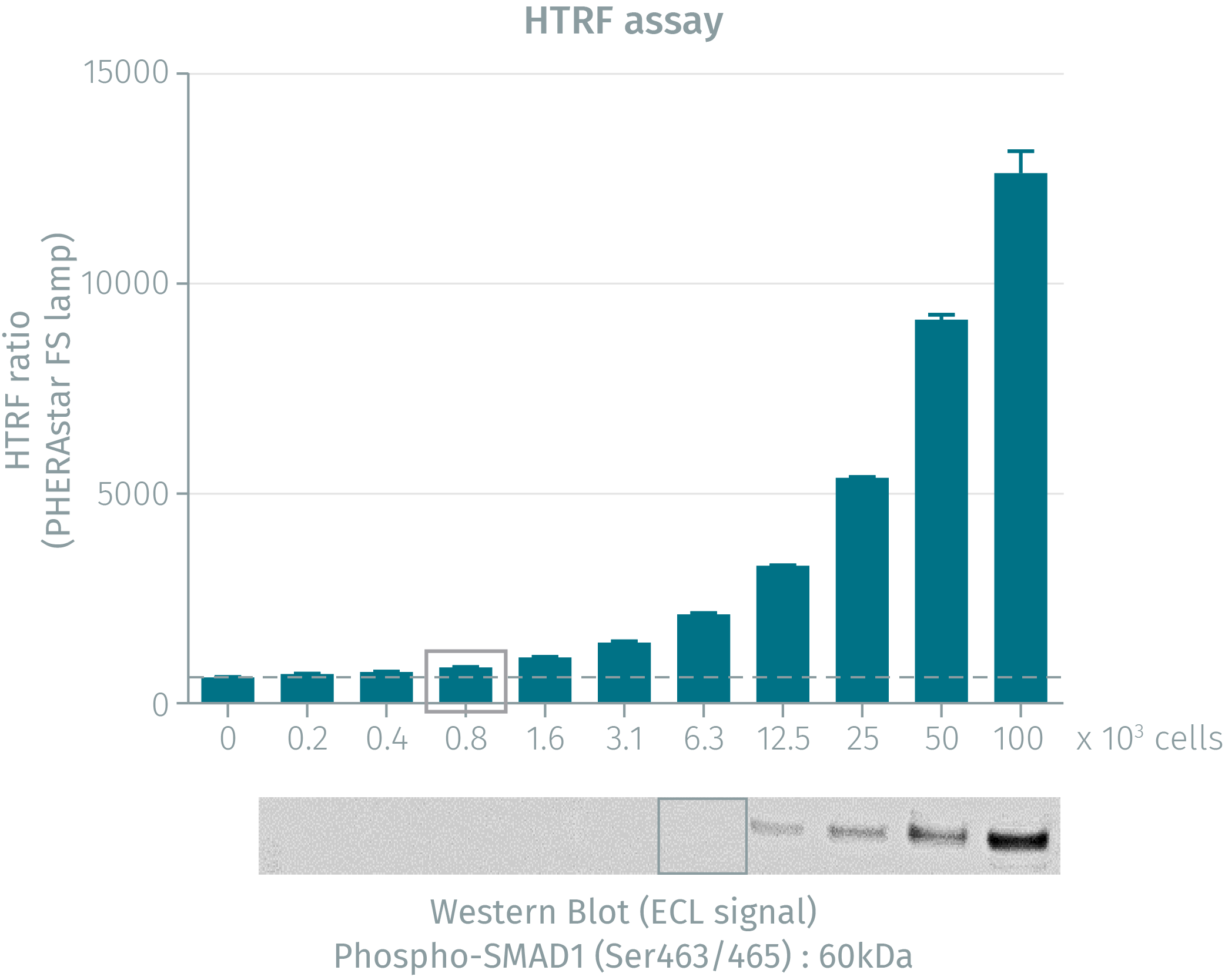

HTRF Human & Mouse Phospho-SMAD1 (Ser463/465) Detection Kit, 500 Assay Points


HTRF Human & Mouse Phospho-SMAD1 (Ser463/465) Detection Kit, 500 Assay Points






Smad1 P-s463/465 Kit - 50,000 Tests
| Feature | Specification |
|---|---|
| Application | Cell Signaling |
| Sample Volume | 16 µL |
Smad1 P-s463/465 Kit - 50,000 Tests



HTRF Human & Mouse Phospho-SMAD1 (Ser463/465) Detection Kit, 500 Assay Points



HTRF Human & Mouse Phospho-SMAD1 (Ser463/465) Detection Kit, 500 Assay Points



Product information
Overview
This HTRF cell-based assay enables rapid, quantitative detection of SMAD1 phosphorylated at Serine 463/465. After phosphorylation and translocation to the nucleus, SMAD1 acts as a transcription factor in regulating the expression of genes involved in stem cell renewal, cell proliferation, apoptosis, migration, differentiation, and immune responses.
Specifications
| Application |
Cell Signaling
|
|---|---|
| Brand |
HTRF
|
| Detection Modality |
HTRF
|
| Lysis Buffer Compatibility |
Lysis Buffer 1
Lysis Buffer 4
Lysis Buffer 5
|
| Molecular Modification |
Phosphorylation
|
| Product Group |
Kit
|
| Sample Volume |
16 µL
|
| Shipping Conditions |
Shipped in Dry Ice
|
| Target Class |
Phosphoproteins
|
| Target Species |
Human
Mouse
|
| Technology |
TR-FRET
|
| Therapeutic Area |
Cardiovascular
Oncology & Inflammation
|
| Unit Size |
500 Assay Points
|
Video gallery

HTRF Human & Mouse Phospho-SMAD1 (Ser463/465) Detection Kit, 500 Assay Points

HTRF Human & Mouse Phospho-SMAD1 (Ser463/465) Detection Kit, 500 Assay Points

How it works
Phospho-SMAD1 (Ser463/465) assay principle
The Phospho-SMAD1 (Ser463/465) assay measures SMAD1 when phosphorylated at Ser463/465. Contrary to Western Blot, the assay is entirely plate-based and does not require gels, electrophoresis or transfer. The Phospho-SMAD1 (Ser463/465) assay uses 2 labeled antibodies: one with a donor fluorophore, the other one with an acceptor. The first antibody is selected for its specific binding to the phosphorylated motif on the protein, the second for its ability to recognize the protein independent of its phosphorylation state. Protein phosphorylation enables an immune-complex formation involving both labeled antibodies and which brings the donor fluorophore into close proximity to the acceptor, thereby generating a FRET signal. Its intensity is directly proportional to the concentration of phosphorylated protein present in the sample, and provides a means of assessing the proteins phosphorylation state under a no-wash assay format.
Phospho-SMAD1 (Ser463/465) 2-plate assay protocol
The 2 plate protocol involves culturing cells in a 96-well plate before lysis then transferring lysates to a 384-well low volume detection plate before adding phospho-SMAD1 (Ser463/465) HTRF detection reagents. This protocol enables the cells' viability and confluence to be monitored.

Phospho-SMAD1 (Ser463/465) 1-plate assay protocol
Detection of Phosphorylated SMAD1 (Ser463/465) with HTRF reagents can be performed in a single plate used for culturing, stimulation and lysis. No washing steps are required. This HTS designed protocol enables miniaturization while maintaining robust HTRF quality.

Assay validation
HTRF assay compared to Western Blot using phospho-Smad1 cellular assay on mouse C2C12 cells
Mouse C2C12 cells were cultured to 80% confluency. After BMP-4 treatment, cells were lysed and soluble supernatants were collected via centrifugation. Serial dilutions of the cell lysate were performed and 16 µL of each dilution were transferred into a 384-well low volume white microplate before finally adding phospho kit reagents. A side by side comparison showed the HTRF Phospho assay is at least 8-fold more sensitive than the Western Blot, and shows optimal correlation.


Validation of the HTRF phospho-SMAD1 (Ser463/465) cellular assay on mouse and human cell lines
Cells were plated in a 96-well plate and incubated for 24h at 37°C, 5% COo2. After treatment for 30 min with BMP-4, cells were lysed, with 50 µL of lysis buffer added for 30min at RT under gentle shaking. 16 µL of lysate were transferred into a 384-well low volume white microplate and 4 µL of the HTRF phospho-SMAD1 (Ser463/465) detection reagents were added. The HTRF signal was recorded after a 4 hour incubation. Human cervical cancer HeLa cells were plated at 50,000 cells/ well and treated with human BMP-4. Mouse myoblast C2C12 cells were plated at 25,000 cells/ well and treated with mouse BMP-4.


Resources
Are you looking for resources, click on the resource type to explore further.
This guide provides you an overview of HTRF applications in several therapeutic areas.


How can we help you?
We are here to answer your questions.






























